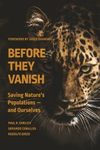About this book
Over the past fifty years, wildlife science has become increasingly quantitative. But to wildlife scientists, many of whom have not been formally trained as biometricians, computer modelers, or mathematicians, the wide array of available techniques for analyzing wildlife populations and habitats can be overwhelming. This practical book aims to help students and professionals alike understand how to use quantitative methods to inform their work in the field.
Covering the most widely used contemporary approaches to the analysis of wildlife populations and habitats, Quantitative Analyses in Wildlife Science is divided into five broad areas:
- general statistical methods
- demographic estimation
- dynamic process modeling
- analysis of spatially-based data on animals and resources
- numerical methods
Addressing a variety of topics, from population estimation and growth trend predictions to the study of migration patterns, this book presents fresh data on such pressing issues as sustainable take, control of invasives, and species reintroduction. Authored by leading researchers in wildlife science, each chapter considers the structure of data in relation to a particular analytical technique, as well as the structure of variation in those data. Providing conceptual and quantitative overviews of modern analytical methods, the techniques covered in this book also apply to conservation research and wildlife policy. Whether a quick refresher or a comprehensive introduction is called for, Quantitative Analyses in Wildlife Science is an indispensable addition to every wildlife professional's bookshelf.
Contents
List of Contributors
Foreword, by R. J. Gutierrez
Preface
Acknowledgments
1. Introduction, by Leonard A. Brennan, Andrew N. Tri, and Bruce G. Marcot
Part I: General Statistical Methods
2. Regression: Linear and Nonlinear, Parametric and Nonparametric, by David B. Wester
3. Multivariate Models and Analyses, by Erica F. Stuber, Christopher C. Chizinski, Jeffrey J. Lusk, and Joseph J. Fontaine
4. Comparing Ecological Models, by Mevin B. Hooten and Evan G. Cooch
Part II: Estimation of Abundance and Demographic Parameters
5. Estimation of Population Parameters Using Marked Animals, by Gary C. White
6. Distance Sampling, by Stephen T. Buckland, David L. Miller, and Eric Rexstad
7. Occupancy Modeling Application, by Chris Sutherland and Daniel Linden
Part III: Dynamic Modeling of Processes
8. Analysis of Population Monitoring Data, by Jamie S. Sanderlin, Michael L. Morrison, and William Block
9. Systems Analysis and Simulation, by Stephen J. DeMaso and Joseph P. Sands
10. Applications of Individual-based Models, by Bruce G. Marcot and Julie A. Heinrichs
11. Detecting and Analyzing Density Dependence, by Zachary S. Ladin and Christopher K. Williams
Part IV: Analysis of Spatially-based Data on Animals and Resources
12. Resource Selection Analysis, by Julianna M.A. Jenkins, Damon B. Lesmeister, and Raymond J. Davis
13. Spatial Statistics in Wildlife Research, by Andrew N. Tri
Part V: Numerical Methods
14. Bayesian Analysis of Molecular Genetics Data, by Randy W. DeYoung and Damon L. Williford
15. Machine Learning, Random Forests and Boosted Regression Trees, by Jane Elith
16. Causal Modeling and the Role of Expert Knowledge, by Bruce G. Marcot
17. Summary and Synthesis: Looking to the Future, by Andrew N. Tri, Bruce G. Marcot, and Leonard A. Brennan
Index
Customer Reviews
Biography
Leonard A. Brennan, a Wildlife Society Fellow, is the C. C. "Charlie" Winn Endowed Chair for Quail Research Professor at the Caesar Kleberg Wildlife Research Institute, Texas A&M University–Kingsville.
Andrew N. Tri is a research wildlife biologist with the Forest Wildlife and Populations Research Group at the Minnesota Department of Natural Resources and an adjunct faculty member at the Caesar Kleberg Wildlife Research Institute, Texas A&M University–Kingsville.
Bruce G. Marcot is a research wildlife biologist with the Pacific Northwest Research Station and the coauthor of Wildlife Habitat Relationships: Concepts and Applications.
Contributors:
- William M. Block
- Leonard A. Brennan
- Stephen T. Buckland
- Christopher C. Chizinski
- Evan C. Cooch
- Raymond J. Davis
- Stephen J. DeMaso
- Randy W. DeYoung
- Jane Elith
- Joseph J. Fontane
- Julie A. Heinrichs
- Mevin B. Hooten
- Julianna M. A. Jenkins
- Zachary S. Laden
- Damon B. Lesmeister
- Daniel Linden
- Jeffrey J. Lusk
- Bruce G. Marcot
- David L. Miller
- Michael L. Morrison
- Eric Rexstad
- Jamie S. Sanderlin
- Joseph P. Sands
- Erica F. Stuber
- Chris Sutherland
- Andrew N. Tri
- David B. Wester
- Gary C. White
- Christopher K. Williams
- Damon L. Williford






































